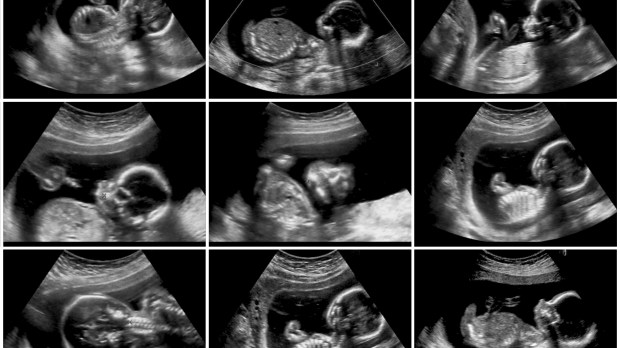During the early days of the Sisters of a Life in the mid-1990s, an elderly physician named Dr. Joseph R. Stanton entrusted his encyclopedic collection of materials related to the Life issues to our religious community. These hundreds of boxes of books, newspaper clippings, letters and files represented his lifetime work as the chief archivist and trusted resource for historical and cutting-edge scientific and medical information in the pro-life movement.
When I was given the task of sorting through these materials 25 years later, I expected to find reams of out-dated information that was either no longer relevant or more easily accessible on the internet. Instead, I found a historical treasure tracing the story of the earliest days of the pro-life movement. I also came to know a man who was a true prophet and a light who continues to guide our efforts to build the Culture of Life today.
Born in 1920, Joe Stanton came from a distinguished family of Boston physicians. (Among his siblings were also a Jesuit priest and three Carmite nuns.) Graduating from Yale Medical school, he regarded the noble calling of the medical profession with great reverence. And so when he learned of the corruption of the medical system in Germany under the Third Reich, he was deeply disturbed.
Even before the Nazis came to power, they had begun to advocate for the sterilization and even extermination of those considered physically or socially unfit. Their propaganda, supported by the prevailing utilitarian philosophy, infiltrated first medical and scientific circles and eventually spread even to high-school mathematics textbooks. Eugenic ideology was popular across the ocean too, and American “compulsory sterilization” techniques were admired by the Nazis as a model of efficiency. In 1939, Hitler signed a letter authorizing certain doctors to extend a “mercy death” to patients who, in their considered judgment, were deserving of it. Ironically, that dubious “benefice” was, like so many privileges, initially withheld from persons of Jewish origin.
In 1939, Hitler signed a letter authorizing certain doctors to extend a “mercy death” to patients who, in their considered judgment, were deserving of it. Ironically, that dubious “benefice” was, like so many privileges, initially withheld from persons of Jewish origin.
These “mercy” doctors reviewed the case files of patients in mental hospitals without ever examining them and then determined whether they should live or die. About 275,000 persons with varying physical or mental disabilities or illnesses were put to death through this program without much outcry. Children watching the stream of transport trucks leaving local institutions commented: “They are taking more people to be gassed.” The scientific and medical communities made no objection, and gratefully received the bodies for research. But once the mass killing methods were “perfected,” the technology and the personnel were quickly moved from the mental hospitals to the death camps of Birkenau and Dachau. And then 6 million Jews were killed simply because they were Jewish.
After WWII, public outrage at the atrocities of the Holocaust dampened the popularity of the eugenics movement. It seemed the world had learned its lesson. But Dr. Stanton recognized the same disregard for the sacredness of human life returning in the early 1970s. He saw his beloved medical profession corrupted first through legalized abortion, and more and more by a utiltarian attitude that evaluated “quality of life” and favored cost-saving schemes over quality of care.
Dr. Stanton saw through the propaganda of the so-called “Right to Die” movement. They claimed to be on the side of compassion, to be advancing the cause of freedom and dignity. Dr. Stanton foresaw where it would end – perhaps not in death-camps – but in a society that judges the burdens of illness and disability to outweigh the gift of loving care and even the value of life itself.
No one wants to be dependent. No one wants to be a burden. Dr. Joseph R. Stanton could speak from experience. He contracted rheumatic fever and polio as a child and spent several months in an iron lung. He was forced to give up his dream of being a surgeon like his father because neither his legs nor his fingers ever regained their full dexterity. But undeterred by his disability, he was a dedicated physician and the father of 10. He was an important figure in the early days of the pro-life movement, tirelessly writing and speaking out on behalf of human life. Dr. Stanton’s dearest legacy was promoting a re-statement of the Hippocratic Oath which he hoped would help preserve the integrity of the medical profession in years to come.
In his later years, Dr. Stanton developed post-polio syndrome and grew increasingly dependent on his wife Mary and his “chair on wheels.” It didn’t stop his pro-life work, but he joked that his wife was enjoying finally being able to push him around. In 1995, Dr. Stanton predicted that if assisted suicide and euthanasia were advanced, it would it not be long before the value of his own life would be called into question, until “the day comes when the door opens and I can’t tell if the caregivers are coming towards me with help or hemlock.” Mysteriously, the relentless tide of the euthanasia movement slowed after his death in 1997 and his prediction would not be realized immediately. But now the tide is rising fast again, as assisted-suicide and euthanasia legislation is introduced and sometimes passed throughout the United States and all over the world.
In 2019, Nicole Gladu was about the same age as Dr. Stanton was when he made that prediction in 1995. Like him, she had contracted polio as a child and was now suffering the disabling effects of post-polio syndrome. Ms. Gladu was one of those who sued the Canadian government, claiming that she was unfairly discriminated against because her condition, while painful, was not “terminal” and therefore she did not qualify for the recently legalized “medical-aid-in-dying.” Her suit succeeded and now she too is eligible to be euthanized in Canada, along with anyone in an “advanced state of decline and enduring intolerable physical or psychological suffering.” Next year this “benefice” will be extended to those suffering solely from mental illness. It is not hard to imagine that the capacity to consent will not endure as a requirement for long.
When I first discovered this tragic irony — that it would be someone with the same condition as Dr. Stanton who would unleash the grim reality he had so long foreseen — I was struck to the heart. And yet, Dr. Stanton’s prophetic voice continues to echo down the decades, presenting not only the danger, but also the response to the march of the Culture of Death. His words illuminate the true call of the medical profession and of each of us entrusted with the care of the most vulnerable:
“In each human being, however burdened by disease or misshapen by age or illness, we must look and see a reflection of the Divine. We must see the image of a God in Whose likeness each living human person was created, ever old, ever new. This perception of the human person, this ideal, given faithful resonance in an often uncaring society, is capable of changing our society, of ending the dehumanization of the sick evident in much of what I have painfully related today. Rudolph Matas, the great surgeon, at the end of his life wrote: ‘The transition between life and death should be gentle in the winter of life.’ Death under these conditions is invested with a certain grandeur and poetry. If it comes to a man when he has completed his mission, there is nothing to fear, nothing to dread. The unchanging challenge to all who truly care about the sick, the suffering, and the dying, is to care so deeply for that patient as a person that in that caring we help the patient live with dignity. We may be confident if we successfully do that, and more especially if we do it in His name, that death, when it comes, will show a patient who has never lost the dignity inherent in the human being. Then at last, we can say with the Poet, ‘O Death where is thy victory? O Grave, where is thy sting?'”
In 2021, the Dr. Joseph R. Stanton Human Life Issues Collection was transferred to the Harvard-Schlesinger Women’s History Library in order to provide greater access to this important resource to scholars and historians. This massive collection of materials is currently being processed.


